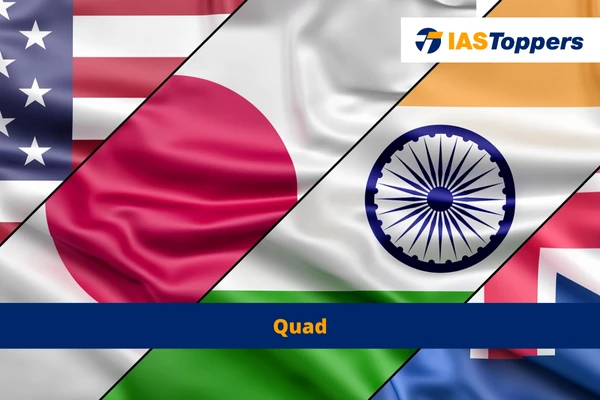QUAD or Quadrilateral Security Dialogue is an informal strategic security dialogue that is conducted between Australia, India, Japan and the United States. In this article, you will learn definition, full form, quad countries list, significance, initiatives, objectives, etc.
This article will provide key insights for GS Paper-II Bilateral and International relations section of UPSC IAS Exam.
Table of Content
- What is a QUAD?
- History of QUAD
- Objectives of QUAD
- Significance of QUAD
- Initiatives of QUAD
- Conclusion
- Frequently Asked Questions
- Reference
What is a QUAD?
- QUAD or Quadrilateral Security Dialogue is an informal strategic security dialogue that is conducted between Australia, India, Japan and the United States.
- It is an alliance of democratic nations who aims to align their interest of maritime cooperation through trade and security.
- As it is an informal group it lacks any Headquarters or permanent Secretariat.
History of QUAD:
Phase-I- 2007-08:
- The occurrence of a Tsunami in the Indian Ocean had led to the alliance of 4 nations that has collaborated for disaster relief efforts.
- Its formation was first initiated by Japanese Prime Minister Shinzo Abe along with the support of Australian Prime Minister, Indian Prime Minister and U.S. Vice President in 2007.
- This led to the formalization of the QUAD.
- Thus, QUAD was formed in 2007.
- The dialogue was also enhanced by conducting joint military exercises known as Exercise Malabar.
- This diplomatic and military arrangement was opinionated to be a response to increased Chinese economic and military power.
- The Australian Prime Minister has withdrawn his support in 2008 fater being protested by China.
- This led to the Exercise Malabar conducted only by India, Japan and the United States.
- The Quadrilateral had initially aimed to establish an “Asian Arc of Democracy“, that will ultimately include countries in Central Asia, Mongolia, the Korean Peninsula, and other countries in Southeast Asia.
No QUAD period 2009–2017:
- Japan joined for the first time the Australian naval exercises in 2008 and 2009.
- Japan and India held for the first time a joint naval exercise in 2012.
- Australia and India did the same in 2015.
- Japan joined for the first time the Indian Malabar exercise in 2015, which was at that time conducted only between US and India after withdrawal of other nations.
Phase II- After 2017:
- During the 2017, Association of Southeast Asian Nations (ASEAN) summit all 4 leaders of the countries have first interacted for QUAD 2.0.
- QUAD group members have agreed to revive the quadrilateral alliance in order to counter China militarily and diplomatically in the Indo–Pacific region.
- This was done specially keeping in mind the South China Sea.
- Unlike earlier, the Quad 2.0 has expanded its objectives by creating a mechanism that determined to establish a rules-based international order.
- During the Quad meeting in 2021, the members have described the spirit of the Quad as “a shared vision for a Free and Open Indo-Pacific,” and a “rules–based maritime order in the East and South China seas.“
- The Quad members state them as necessary to counter Chinese maritime claims.
- At the first Quad summit of 2021 had explored a partnership with Europe.
- Since 2021, members of the Quad and their leaders have regularly hosted “Leaders Summits”, including both online and in-person.
- There were two QUAD summit organized in 2022 that has discussed the situation of Ukraine.
Objectives of QUAD:
- To secure a rules-based global order, a liberal trading system, and freedom of navigation.
- To work against predatory trade and economic policies.
- To offer financial help to nations with debt in the Indo-Pacific region.
- The primary objective of the QUAD is to:
- Safeguard strategic sea routes in the Indo-Pacific region
- Ensure the freedom of strategic sea routes from any external influence
- Promote a rules-based global order, fair trading system, and unrestricted navigation
Significance of QUAD:
- As of 2023, Quad countries together have a:
- Combined nominal Gross domestic product (GDP) of US$36.7 trillion (34.7% of the gross world product)
- Combined GDP PPP (Purchasing Power Parity) of US$48.1 (27.5% of the world’s GDP)
- All its members are democratic countries.
Initiatives of QUAD:
- The Quad pledged to respond to COVID-19 by organizing its first Quad Plus meeting that also included representatives from South Korea, New Zealand, and Vietnam.
- Indo-Pacific Partnership for Maritime Domain Awareness (IPMDA) was launched in 2022 in order to bridge infrastructure gaps and a collective approach to enhanced cyber-security.
- Humanitarian assistance and disaster relief (HADR) will be established in the Indo-Pacific, which will strengthen efforts to respond to disasters.
- The Quad will advance interoperability and security through a new memorandum of cooperation on 5Gsupplier diversification and Open RAN.
- Open RAN enables mobile network operators to ensure inter–operability while using equipment from multiple vendors.
- All its members will advance cooperation on semiconductors and other critical technologies.
Conclusion
The QUAD (Quadrilateral Security Dialogue) represents a significant multilateral partnership among Australia, India, Japan, and the United States. The QUAD has gained prominence as a platform for dialogue and cooperation on a range of strategic and security issues. The QUAD countries have the potential to shape regional dynamics and contribute to a more secure and prosperous future. QUAD summit is regularly held to maintain cooperation amongst its member states.
Ref: Source-1
FAQs (Frequently Asked Questions)
What is QUAD summit?
QUAD summit is a Quadrilateral Security Dialogue or an informal strategic security dialogue that is conducted between Australia, India, Japan and the United States.
When was QUAD established?
QUAD was established in 2007.
Who was the initiator of the QUAD?
The Japanese Prime Minister Shinzo Abe had first initiated the talks to establish QUAD between the 4 nations.




